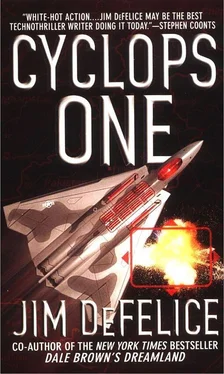The radar in the F/A-22Vs had been developed from the original APG-77 perfected by Northrop Grumman and Raytheon, the first active-array antenna radar fitted into a fighter aircraft, but the Velociraptor version was nearly as far from its ancestor as the APG-77 had been from its own predecessors. Unlike old-fashioned radar “dishes,” the radar signals were sent and received through nearly two thousand short antennas carefully arranged around the aircraft’s hull. The embedded array allowed the radar to operate in a variety of modes at once, essentially giving complete and instantaneous coverage while still employing low-probability-of-intercept tactics. In an older radar the sweep of the beam and spikes in the energy levels provided easy detection points for a careful enemy. The F/A-22V — and even the “stock” F/A-22—could use its active radar and still not be detected by most interceptors until it had already fired air-to-air missiles — in other words, until it was far, far too late. The aircraft’s eighteen different modes were capable of working together so that a long-range target might be found, identified, and targeted seemingly instantaneously. The targets were passed along immediately through the intraflight data link (IFDL) to Cyclops, which would then use the information to nail them.
The tough thing, the almost impossible thing, was the length of the mission. The planners were convinced the attack would go off as soon as it was completely dark, which would be roughly an hour from now. But there were no guarantees, and even the long-legged F/A-22Vs would eventually get thirsty. Howe and Timmy had worked out a plan to swap off on refuels several hours into the flight; the complicated fuel matrixes were stored in the Velociraptors’ computers, and the flight computer had a preset panel that would show their fuel profiles throughout the mission.
Maybe it wouldn’t come off at all. The diplomats were supposedly burning their own dinosaurs on the ground, trying to cool things down.
“Bird Two to One,” snapped Timmy. “Hey, boss man, how’s it looking?”
“We’re clean,” Howe told his wingman. “Eight minutes to border.”
“Roger that.”
Timmy was flying at a five thousand feet offset a mile off his right wing at 38,000 feet. Once over the border, they were going to run one circuit through the mountainous area together to get their bearings, then split up to cover more territory, in case the analysts’ guesses were off the mark. The automatic ground modes on their radars would hunt for any hidden bases, allowing the Cyclops Two operators to rule out — or in — possible surprises.
The AWACS checked in, relaying a report from one of the Navy surveillance craft helping to monitor the peninsula that the Indians were launching one of their Russian Beriev A-50 “Mainstay” radar aircraft from a base to the southeast, near the coast. The Mainstay was more than five hundred miles from their patrol area, and its radar range was less than two hundred miles. Unless it got considerably closer, it was unlikely to pinpoint the stealthy F/A-22Vs, and still less likely to be able to vector anything toward them.
Even so, Howe felt himself leaning forward on the seat. He edged his thumb along the top of the sidestick, watching the computer count down the time to the border in the course module above his left multiuse display. Howe checked the aircraft data, took a slow breath, and flexed fingers on the throttle. It was getting fairly dark now, and so he push-buttoned the HUD into synthetic view, the hologram rendering the outside world at a one-on-one scale/first person. The fishbowl before him duplicated what he would have seen if it were a perfectly clear day. He stared at it a second, mentally orienting his eyes and brain to accept the synthetic data, then flicked into one-on-ten, which felt a little like watching an O-scale train layout instantly downsize to HO. He enabled verbal commands, then had the Velociraptor’s computer pencil in some geography and flight plan data. He could see the border etched out on the virtual ground ahead.
Megan wasn’t gone from his memory, but she’d been pushed back, his anger and other feelings corralled.
Corralled, not eliminated.
“Bird Two, we have thirty seconds. You ready, partner?”
“Piece of cake,” said Timmy.
Howe counted down the last few seconds, then goosed the engine. The two F/A-22Vs rocketed over the Indian coast, knifing through the darkness.
Two minutes later the radar detector in Howe’s plane began to bleat. The system identified and located the radar, an early-warning ground station southeast of Charsadda, rendered as a purple dish icon in the far reaches of the hologram’s dusty 3-D hills. The radar was attached to a Crotale 2000 surface-to-air missile system, a relatively short-range mobile SAM intended primarily for point defense of airfields and other strategic targets. The radar could not see the Velociraptors, nor would the missiles it guided present much of a challenge to the aircraft’s ECM suite if it came to that. Nonetheless, the avionics system made note of them, opening a file and storing the data for the pilot’s reference. If Howe wished, he could direct the computer to present him with a list of options for eliminating the radar and its missiles; one button and one verbal command later, a small-diameter GPS-guided bomb would spit from the Velociraptor’s belly and the radar would be history.
If Howe wished.
“Bird One, this is Big Eyes,” said the AWACS controller. “Be advised, Indra is airborne.”
Indra was the code name they’d settled on for India’s northern-based Phalcon AEW aircraft, arguably the only serious threat to the mission. The 767’s multisensor radars could provide early-warning and tracking data, serving in a somewhat similar capacity as an AWACS. While not the equal of American systems, it was still impressive — and in theory capable of finding the F/A-22Vs, or at least their radar transmissions. Indra flew regularly, and its launch was not unexpected — in fact, just the opposite. Howe took it as confirmation that the mission was a go. The AWACS would keep tabs on the aircraft, which presently was several hundred miles to the south of Howe’s flight path.
“Bird One,” acknowledged Howe.
McIntyre unfolded himself from the helicopter seat and walked unsteadily across the cabin. The damn thing shook like a washing machine, and the metal was so thin he worried he’d put his hand through the side as he steadied himself before stepping out onto the tarmac with his bag. If it wasn’t the oldest helicopter in the Indian inventory, it had to be in the running. As he stepped out, grit flit into his eye; he walked forward blindly, half expecting to be decapitated by the rotors even though he was bent forward.
The helicopter fanned the air behind him, rushing away in the dusk. The mountains cast an odd green-purple glow over everything as night fell; the dim light made him feel even more tired, and McIntyre was glad this was his last stop for the night. He’d been to several bases over the course of the day, each one duller than the rest. Hopefully the CIA guys were gathering better information.
A figure in brown stood to the right, blurring into the dusk. McIntyre worked his thumb against the corner of his eye, trying to clear it.
“Damn dirt has glue in it,” he said, trying to make a joke.
The blur didn’t speak. McIntyre finally pushed his eyelids apart, trying to bring the blur into focus. All he could see was the man’s frown.
“Name’s McIntyre,” he said, letting go of his eye and holding out his right hand to shake. The man, a captain, didn’t take it.
“I’m to show you around,” said the officer.
“Let’s start with the john, then,” said McIntyre. He grabbed his bag and waited for the blur to move. By now his eye was tearing uncontrollably; McIntyre realized that he ought to just let the tears clear out the grit, but it was difficult to avoid the urge to rub. Finally the Indian captain began to move toward a gray cloud on the right. McIntyre followed, gradually gaining his sight as he went.
Читать дальше












